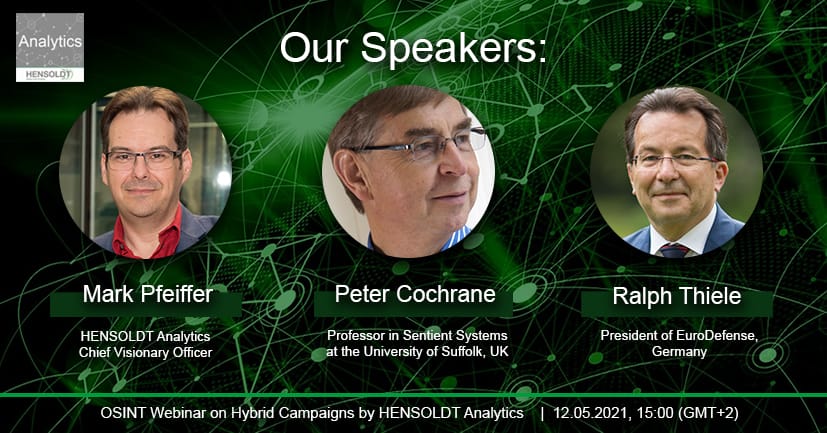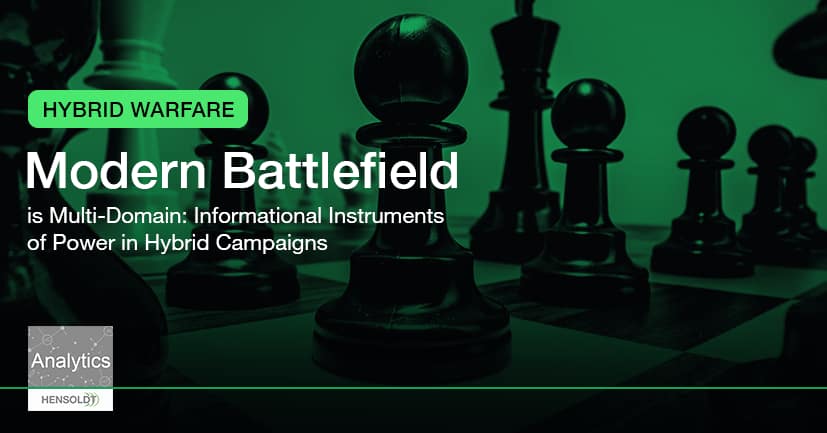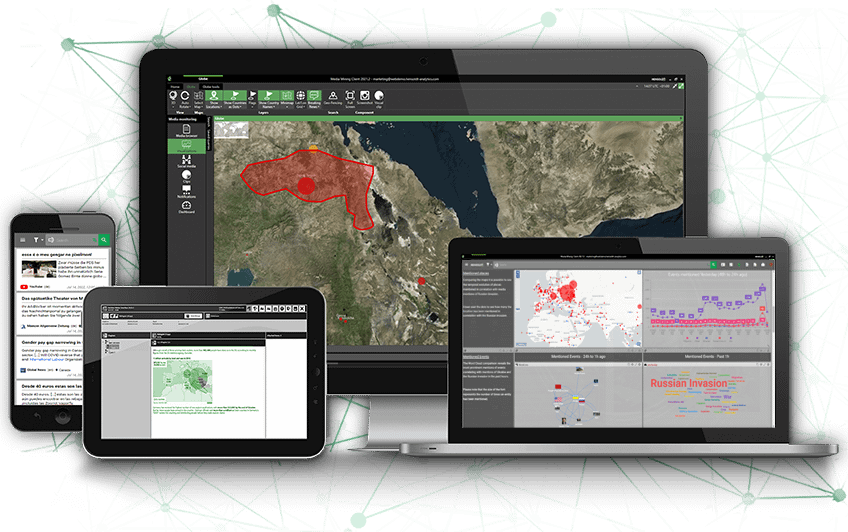This article is a written summary of the webinar. If you would like to watch the recording of the event, you can visit HENSOLDT Analytics’ YouTube Channel.
On the 12th of May, we had the pleasure to host a virtual event exploring the state of contemporary hybrid warfare, as well as the role of fake news and disinformation. The number of registered participants greatly exceeded our expectations, setting an exciting precedent for this year’s series of virtual events. This particular webinar was not only the first virtual get-together of the year – it was also our first webinar as a member of the HENSOLDT family.
The “Informational Instruments of Power in Hybrid Campaigns & The Role of Disinformation and Fake News” was presented by three distinguished experts in the realm of intelligence, security, and information technology:
- Ralph Thiele, the President of EuroDefense-Germany, Chairman of the Political-Military Society, Germany, and Managing Director at StratByrd Consulting, Germany, who brought a wealth of national and international security and military insights to the table.
- Mark Pfeiffer, HENSOLDT Analytics Chief Visionary Officer, with more than two decades of economics, intelligence systems, and aeronautics experience under his belt. In 2006 he co-founded the EUROSINT forum as a venue for the exchange of ideas and concepts. His trainings in the OSINT domain are highly customized to the clients’ needs and he can draw from many years of customer interaction, primarily consulting in the field.
- Peter Cochrane, an international sought-after advisor and consultant with over 40 years of technology and operational experience. Peter is a former British Telecom CTO and a renowned academic, recognized for his work through numerous titles and awards.

Tide Change – Informational Instruments of Power
Ralph Thiele was the first to take the virtual stage, introducing the international audience to the contemporary Instruments of Power model.
Instruments of Power term refers to “the tools a country uses to influence other countries or international organizations or even non-state actors“ (definition sourced from “JFODS5: The Joint Forces Operations & Doctrine SMARTbook, 5th Ed. (Guide to Joint, Multinational & Interorganizational Operations)” via The Lightning Press). Ralph Thiele elaborated on the number of actors shaping and accelerating the landscape of modern hybrid warfare, naming two big players, China and Russia respectively, in this domain. „Hybrid challenges expand the battlefield into a multi-domain battlespace”, emphasized Ralph Thiele.
While in the past the military held the bigger share of Instruments of Powers, nowadays the most innovative technological solutions utilized in information works are increasingly non-military. Commercial tools are also widely available – this state of affairs opens doors to new players wanting to participate in hybrid action.

With the rapid development of the technological landscape, the multifaceted threats in the intelligence gathering area demand governments to invest more time, effort, and money to keep up the pace. Moreover, Ralph Thiele pointed that technology and hybrid warfare are mutually dependent -technology is a catalyst for respective methods and tools while at the same time broadening the range of hybrid warfare available to the governments. In result, the development of intelligence gathering and employment solutions, the Informational Instruments of Power, has to go hand in hand with the evolution of the virtual and physical data landscapes.
Application of OSINT in Countering Hybrid Warfare
Mark Pfeiffer further elaborated on modern hybrid warfare’s utilization of informational instruments of power.
The primary goal of hybrid warfare actors weaponizing information is to destabilize the adversary. Destabilization can take different forms such as creating an environment of polarization, which leads to social unrest; nurturing distrust towards institutions and actions thus eroding the influence of the governing bodies. All of these, to different degrees, lead to the weakening of societies.

In modern times, „trust is the currency of hybrid actors”, stated Mark Pfeiffer explaining the means of hybrid actors in the ever-expanding and much more diverse than ever before media landscape we are currently witnessing. The trust in traditional media vs emerging media is still much higher. According to EBU’s Trust in Media 2019 Report, “Broadcast media are the most trusted media throughout Europe. Radio is trusted in 85% of European countries, TV in 75%. Trust in online media is in constant decline, with social networks being the least trusted media in 88% of European countries.” On the other hand, in countries with state-owned traditional media, the trustworthiness of social media increases. The level of influence attributed to the medium of communication will dictate the course of hybrid actions. Mark went further to explain and demonstrate using interactive dashboards from our own system, that the entire media landscape (both traditional and new/social media) is considered within the framework of the HENSOLDT Analytics OSINT system, giving the hybrid actors an informational advantage.
At the same time, hybrid actors cannot afford to skim the surface of informational skirmishes. An important point made by Mark is that HENSOLDT Analytics system allows users to uncover events that received low media attention worldwide, yet were of great significance. For example, the US 2020 elections became an unintentional smokescreen for military actions elsewhere in the world. Gaining situational awareness in real-time allows hybrid actors to anticipate the inevitable global ripple effects of local events.
Connecting the Dots with Context Awareness
Last but not least to present was Peter Cochrane, who brilliantly drove the following point home: regardless of the volume of intelligence, context awareness is an essential component of decision making.
Peter Cochrane dedicated his talk to the delicate interconnectedness of truth, situation, and context when analyzing intel. Not anticipating the threats is costly – both in terms of societal and economic impact. The complex interdependency of information domains makes it difficult for governments to distinguish sources of reliable information. Right now the number of connected dots for every piece of information is ever-growing, making it impossible to map out the entire information network. This is why we need to employ technology rather than rely on human judgment to come to the right conclusions. Luckily, we already have the technology needed to properly analyze the context of information.
Modern hybrid warfare is executed across longer periods of time to slowly chip away at the trust foundation within the society of the target. This is why the intelligence systems have to be responsive to long-term monitoring and engage in deep observation and analysis of the situation. The data has to be applied to the wider context to reveal unknowns and contingencies. This, postulated Peter Cochrane, calls for minimization conditions that foster errors, for example, focusing on narrow situation modelling or not factoring in human and machine cognitive bias.
Peter Cochrane closed his presentation reminding participants that there is no linearity we can rely on. A wholesome understanding of the relationship between situation, truth, as well as context, is a crucial triumvirate component in facing hybrid challenges of modern warfare.





